Clay teapots are perfect for brewing herbal teas due to their unique properties. The natural porosity of clay creates microscopic air pockets that enhance flavor interaction, allowing the teapot to absorb and retain flavors over time. These pots also excel at heat retention, maintaining ideal brewing temperatures for longer periods. The mineral-rich clay interacts with herbs, adding depth and complexity to your brew. As you use your clay teapot, it develops a natural seasoning that further improves its tea-making capabilities. Beyond functionality, clay teapots offer timeless beauty and craftsmanship. There's much more to discover about the magic of clay teapots and herbal infusions.
The Porosity of Clay Teapots
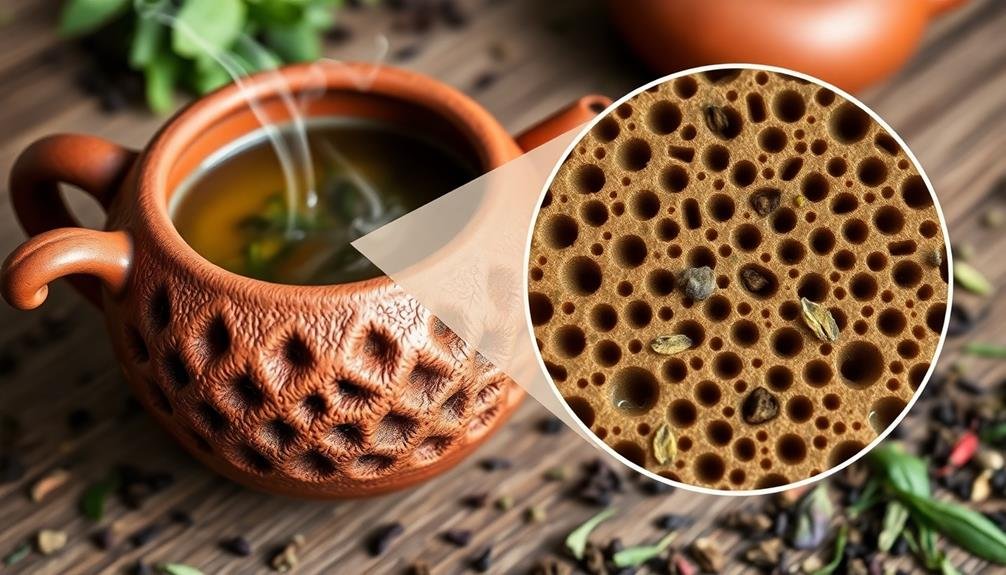
When it comes to clay teapots, porosity plays an essential role in enhancing the tea-drinking experience. Clay's natural porosity allows for microscopic air pockets within the teapot's walls, which interact with your herbal tea in unique ways. As you brew your tea, these tiny pores absorb some of the liquid, retaining flavors and aromas over time.
You'll notice that with repeated use, your clay teapot develops a seasoned patina. This seasoning isn't just cosmetic; it's a result of the tea oils seeping into the clay's pores. Each brew adds to this flavor profile, making your teapot more valuable and enhancing future infusions.
The porosity also affects heat retention. Clay's porous nature helps maintain a consistent temperature throughout the brewing process, ensuring your tea steeps evenly. You'll find that this property is especially beneficial for delicate herbal teas that require precise temperature control.
However, it's essential to recognize that clay's porosity means you shouldn't use soap when cleaning your teapot. Instead, simply rinse it with hot water to preserve the seasoning and prevent unwanted flavors from seeping into the pores.
Heat Retention Properties
Building on the thermal properties mentioned earlier, clay teapots excel in heat retention. You'll find that these vessels maintain your herbal tea's temperature for longer periods compared to other materials. This characteristic is due to clay's low thermal conductivity, which means it doesn't readily transfer heat to the surrounding environment.
When you brew your herbal tea in a clay teapot, the pot's walls absorb and distribute heat evenly. This process creates a consistent temperature throughout the brewing cycle, ensuring ideal extraction of flavors and beneficial compounds from your herbs.
As you pour your tea, you'll notice it stays warmer for extended periods, allowing you to savor each sip without rushing.
The heat retention properties of clay teapots also contribute to a more enjoyable drinking experience. You won't need to reheat your tea as frequently, preserving its delicate flavors and aromas.
Additionally, the gradual cooling process can enhance your tea's taste profile, revealing subtle nuances that might be missed when consumed too quickly.
Flavor Enhancement Capabilities
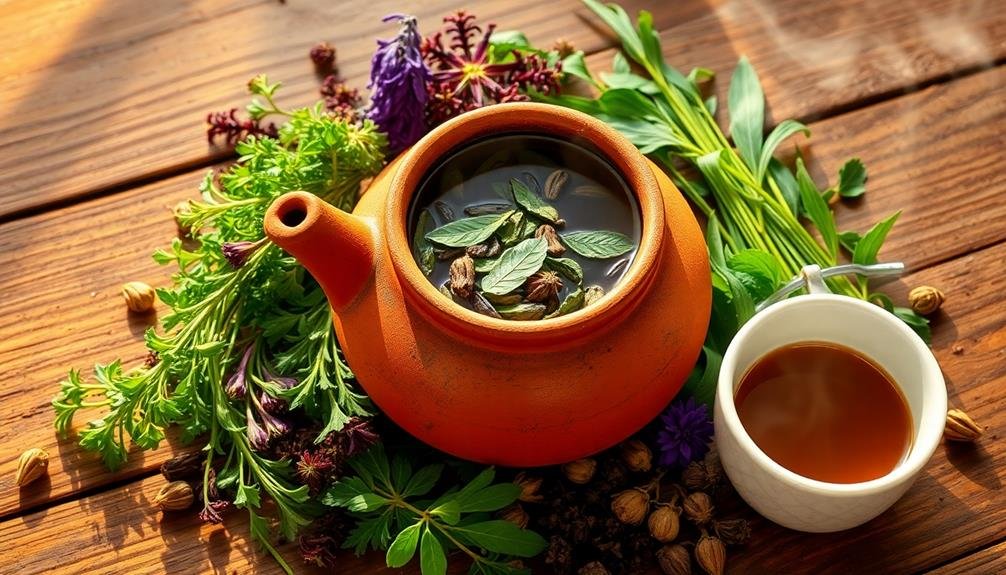
You'll find that clay teapots offer unique flavor enhancement capabilities for your herbal teas.
The porous structure of clay absorbs and retains the subtle flavors of your brews, gradually building up a seasoned interior that enriches future infusions.
Additionally, the mineral-rich composition of clay can interact with your tea, potentially adding depth and complexity to its taste profile.
Porous Structure Absorbs Flavors
Clay teapots possess a remarkable ability to enhance the flavor of herbal teas through their porous structure. This unique characteristic allows the clay to absorb the subtle flavors and aromas of the herbs you brew.
Over time, your teapot will develop a rich patina, infused with the essence of your favorite teas. When you use a clay teapot regularly, you'll notice that each subsequent brew becomes more flavorful and complex.
The tiny pores in the clay act like a sponge, soaking up the tea's essence and releasing it back into future infusions. This process creates a layered taste experience that you won't find with other materials.
You'll find that certain herbs pair exceptionally well with clay teapots. Earthy teas like pu-erh or robust herbal blends will benefit most from the clay's absorptive properties.
As you continue to use your teapot, you'll discover that it becomes seasoned, much like a cast-iron skillet. This seasoning enhances the overall taste profile of your teas, making each cup a unique and personalized experience.
Mineral-Rich Clay Interactions
Beyond the porous structure, the mineral-rich composition of clay teapots plays a significant role in flavor enhancement. When you brew herbal teas in these vessels, you're initiating a complex interaction between the minerals in the clay and the compounds in your tea. This process can subtly alter and improve the flavor profile of your brew.
The mineral content of clay teapots varies depending on their origin and manufacturing process. You'll find that different types of clay can impart unique characteristics to your tea:
| Clay Type | Mineral Content | Effect on Tea |
|---|---|---|
| Yixing | Iron-rich | Enhances depth |
| Tokoname | High in silica | Softens taste |
| Nixing | Quartz-rich | Improves clarity |
As you use your clay teapot over time, it'll continue to absorb trace elements from your teas. This gradual seasoning process creates a symbiotic relationship between the pot and your favorite brews. You'll notice that the flavors become more pronounced and nuanced with each use, as the minerals in the clay interact with the tea's compounds, potentially revealing new taste dimensions you hadn't experienced before.
Natural Seasoning Over Time
Your clay teapot will naturally season over time, gradually enhancing the flavors of your herbal teas.
As you brew different teas, the porous clay absorbs minute amounts of their properties, creating a unique flavor profile.
This seasoning process also develops a distinctive patina on your teapot, both inside and out, making it a truly personalized brewing vessel.
Flavor Enhancement Process
The natural seasoning process of clay teapots enhances the flavor of herbal teas over time. As you brew tea in your clay pot, it absorbs the oils and essences from the herbs, slowly building up a seasoned layer inside the porous clay. This layer retains the flavors and aromas of previously brewed teas, adding depth and complexity to future infusions.
You'll notice that the more you use your clay teapot, the better your herbal teas will taste. The pot's ability to retain heat also contributes to this enhancement, allowing for a more thorough extraction of the herbs' beneficial compounds. To maximize this process, it's best to dedicate your clay teapot to a specific type or family of herbal teas.
As the seasoning develops, you may observe a slight change in the pot's appearance, with the interior becoming smoother and taking on a subtle sheen. This visual transformation is a sign that your teapot is maturing and improving its tea-making capabilities.
Absorbing Tea Properties
Clay teapots' natural seasoning process goes hand in hand with their ability to absorb tea properties over time. As you brew herbal teas in your clay teapot, you'll notice that it gradually takes on the flavors and aromas of the herbs you use most frequently. This absorption occurs because clay is a porous material, allowing it to retain small amounts of tea with each brewing session.
The more you use your clay teapot, the more it'll develop a unique character. You'll find that over time, your teapot enhances the flavors of your favorite herbal blends, making each cup more aromatic and flavorful. This natural seasoning process is particularly beneficial for teas with delicate flavors, as the absorbed properties can complement and intensify these subtle notes.
To maximize this effect, it's best to dedicate your clay teapot to a specific type of herbal tea or similar flavor profiles. By doing so, you'll create a teapot that's perfectly suited to brewing your preferred herbal blends, resulting in a more refined and enjoyable tea-drinking experience.
The absorbed tea properties will continue to develop, making each brew uniquely tailored to your taste preferences.
Unique Patina Development
As you use your clay teapot over time, you'll notice a fascinating transformation taking place. The porous surface of the clay begins to develop a unique patina, a natural seasoning that enhances the teapot's character and functionality. This patina is the result of countless brewing sessions, where the clay absorbs minute amounts of tea oils and flavors.
The development of this patina offers several benefits:
- Improved flavor: The seasoned surface adds subtle depth to your brews
- Enhanced heat retention: The patina creates a more insulating layer
- Increased durability: The seasoning helps protect the clay from damage
You'll find that your clay teapot becomes more valuable and personalized with each use. The patina's color and sheen will vary depending on the types of teas you brew most frequently.
Darker teas like pu-erh will create a richer, deeper patina, while lighter herbal infusions may result in a more subtle sheen. This unique aging process not only improves your tea-drinking experience but also creates a beautiful, one-of-a-kind vessel that tells the story of your tea journey.
Aesthetic Appeal and Craftsmanship
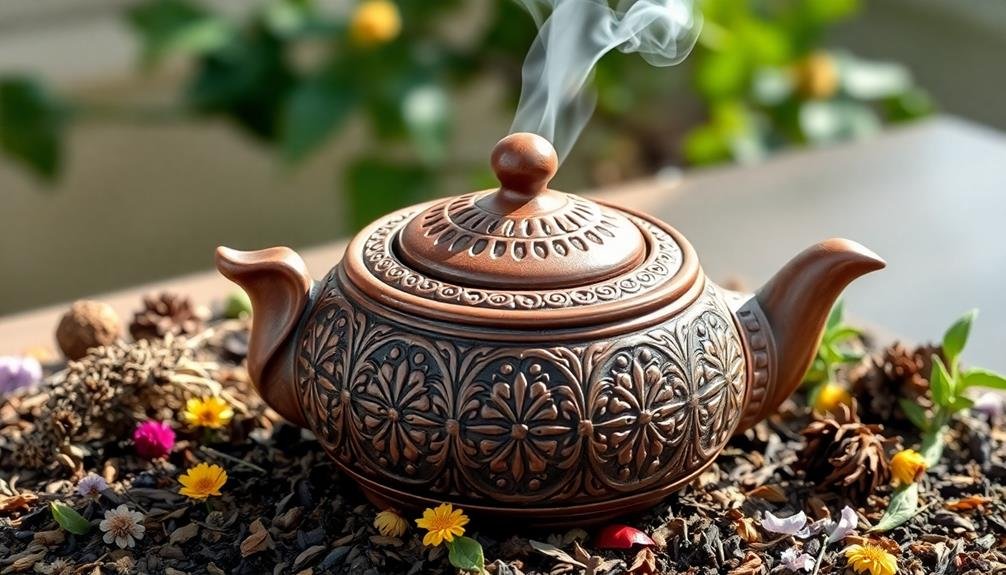
Renowned for their timeless beauty, clay teapots offer more than just functional appeal. You'll find that these artisanal pieces showcase the skilled craftsmanship of their creators, with each teapot being a unique work of art.
The natural, earthy tones of clay teapots add warmth and character to your tea-drinking experience, making them a visually pleasing addition to your kitchen or dining area.
As you examine a clay teapot, you'll notice the intricate details and textures that skilled artisans incorporate into their designs. From delicate carvings to subtle variations in shape, these elements contribute to the teapot's overall aesthetic charm.
The organic forms of clay teapots often mimic nature, with some resembling gourds, pebbles, or other natural objects.
You'll appreciate how the teapot's appearance evolves over time, developing a rich patina that tells the story of its use. This aging process enhances the teapot's visual appeal, making it a cherished heirloom that can be passed down through generations.
The combination of functionality and beauty makes clay teapots a favorite among tea enthusiasts and collectors alike.
Environmental Sustainability
Considering the environmental impact of your tea brewing choices, clay teapots offer a sustainable alternative to plastic or metal options. These natural vessels are biodegradable and don't contribute to microplastic pollution.
When you choose a clay teapot, you're opting for a product that's typically handcrafted using traditional methods, which often have a lower carbon footprint than mass-produced alternatives.
Clay teapots are also incredibly durable, lasting for years with proper care. This longevity reduces the need for frequent replacements, ultimately decreasing waste.
In addition, many artisans use locally sourced clay, further reducing the environmental impact associated with transportation.
When you invest in a clay teapot, you're supporting:
- Sustainable craftsmanship
- Reduction of plastic waste
- Preservation of traditional skills
As you enjoy your herbal teas, you'll appreciate knowing that your brewing method aligns with eco-friendly practices.
The porous nature of clay allows for natural air circulation, enhancing the flavor of your tea without relying on artificial materials or processes.
Traditional Brewing Techniques
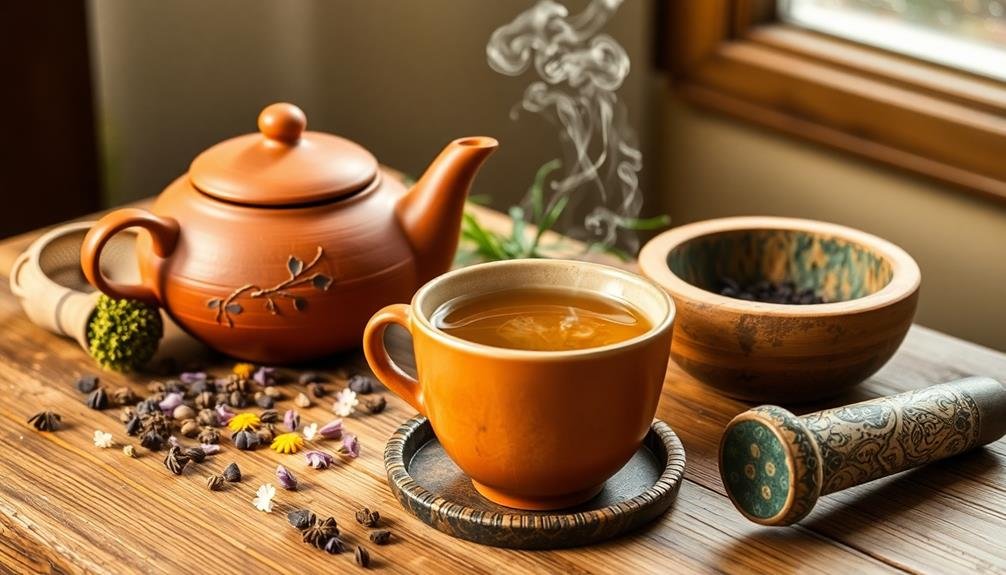
When brewing herbal teas in clay teapots, you'll find traditional techniques like the Gongfu Tea Ceremony can enhance your experience.
You'll want to pay close attention to steeping times and temperatures, as these factors considerably impact the flavor and potency of your brew.
Gongfu Tea Ceremony
The ancient art of Gongfu tea brewing elevates herbal tea preparation to a meditative ritual. When using clay teapots for this ceremony, you'll experience a unique connection between the tea, the vessel, and yourself. The porous nature of clay allows for subtle flavor enhancement, making it ideal for delicate herbal infusions.
To perform the Gongfu ceremony with your clay teapot, you'll need to master a few key techniques. First, preheat your teapot and cups with hot water. Then, add your chosen herbs to the warm pot, using about 1 gram of tea per 15ml of water. Pour water just off the boil over the herbs, allowing them to steep for 30 seconds to 2 minutes, depending on the blend.
The Gongfu method emphasizes:
- Multiple short infusions to explore the tea's evolving flavors
- Mindful pouring and serving techniques
- Appreciation of the tea's aroma, color, and taste
As you practice the Gongfu ceremony with your clay teapot, you'll develop a deeper understanding of herbal teas and their nuances. This method allows you to fully immerse yourself in the tea-drinking experience, savoring each sip with heightened awareness.
Steeping Times and Temperatures
Mastery of steeping times and temperatures is essential for extracting the best flavors from herbal teas in clay teapots. You'll find that different herbs require varying steeping times and water temperatures to achieve satisfactory taste and health benefits.
For delicate herbs like chamomile or mint, you'll want to use water that's around 175°F (80°C) and steep for 3-5 minutes. Heartier herbs such as ginger or rooibos can handle hotter water, up to 212°F (100°C), and longer steeping times of 5-7 minutes.
Clay teapots excel at maintaining consistent temperatures, which is vital for achieving the perfect brew. When using a clay teapot, preheat it by rinsing with hot water before adding your herbs. This helps maintain the ideal temperature throughout the steeping process.
As you experiment with different herbs, adjust your steeping times and temperatures accordingly. Start with the recommended guidelines, then tweak them to suit your personal taste preferences.
Clay Types for Teapots
Over the years, potters have identified several clay types ideal for crafting teapots. The most popular varieties include Yixing clay, porcelain, and stoneware. Each type offers unique properties that can enhance your herbal tea experience.
Yixing clay, sourced from China's Jiangsu province, is prized for its high mineral content and porous nature. It's known to absorb tea flavors over time, creating a seasoned pot that enhances future brews.
Porcelain, on the other hand, is non-porous and doesn't retain flavors, making it versatile for various tea types. Stoneware strikes a balance between the two, offering some porosity while being more durable than Yixing clay.
When choosing a clay teapot for herbal teas, consider these factors:
- Heat retention: Denser clays like Yixing retain heat longer, keeping your tea warm.
- Flavor neutrality: Porcelain won't affect tea taste, while Yixing may subtly alter flavors.
- Maintenance: Stoneware is often easier to clean and more resistant to thermal shock.
Your choice will depend on personal preferences and the specific herbal teas you enjoy.
Experiment with different clay types to find the perfect match for your tea rituals.
Compatibility With Herbal Infusions
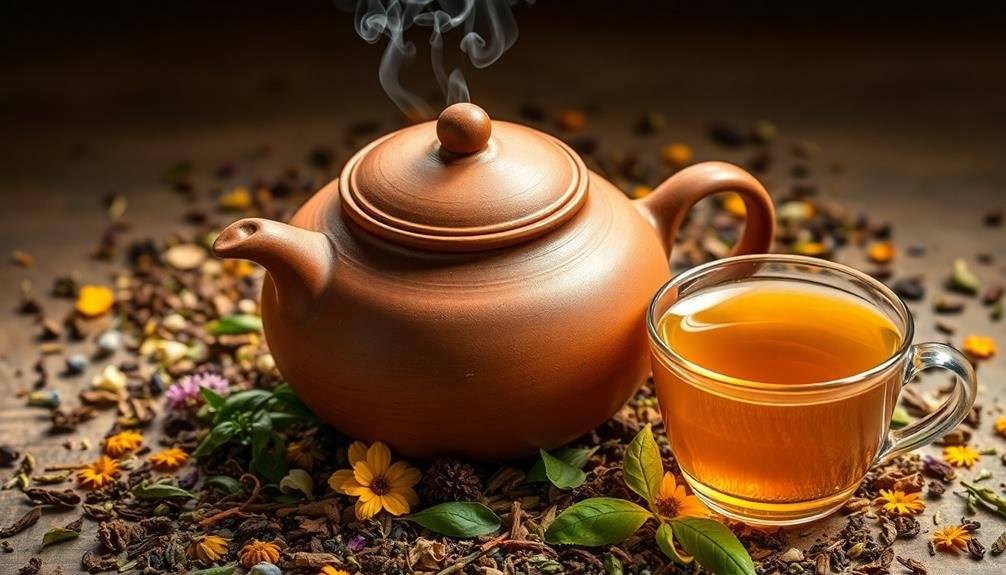
Selecting the right clay teapot for your herbal infusions can substantially enhance your tea-drinking experience. Clay teapots are particularly compatible with herbal teas due to their porous nature and ability to retain heat. The clay's microporosity allows for a subtle exchange of flavors, enhancing the complexity of your herbal infusions.
When choosing a clay teapot for herbal teas, evaluate the specific herbs you'll be using. Yixing clay, for instance, works well with robust herbs like ginger or peppermint, as it can absorb and mellow strong flavors.
For delicate herbs like chamomile or lavender, a less porous clay like kaolin might be more suitable to preserve the tea's subtle notes.
You'll also want to assess the pH level of your herbal infusions. Some clays interact better with acidic teas, while others are more suitable for alkaline blends.
It's best to dedicate a specific clay teapot to a particular type of herbal tea to avoid flavor contamination. This practice allows the teapot to develop a patina over time, further enhancing the taste of your favorite herbal blends.
Maintenance and Care
How can you guarantee your clay teapot remains in prime condition for years to come? Proper maintenance is key to preserving your teapot's quality and enhancing its brewing capabilities.
After each use, rinse your clay teapot with warm water only—avoid soap, as it can leave residues that affect the flavor of future brews. Allow the teapot to air dry completely before storing it in a well-ventilated area.
To keep your clay teapot in prime condition, follow these essential care tips:
- Season your teapot regularly by brewing tea and allowing it to steep for extended periods.
- Avoid sudden temperature changes, which can cause cracking.
- Use a soft brush to gently clean the teapot's exterior, removing any buildup or stains.
Over time, your clay teapot will develop a natural patina, enhancing its appearance and brewing qualities.
If you notice any mineral deposits inside the pot, simply brew a strong black tea and let it sit overnight. This will help dissolve the buildup and maintain the teapot's porous nature.
Health Benefits of Clay
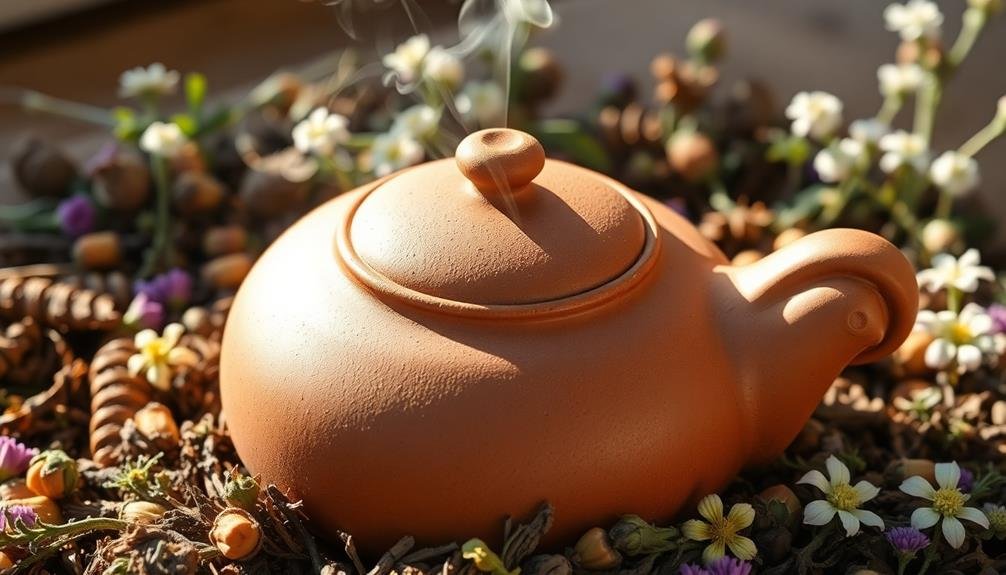
Clay teapots offer more than just a unique brewing experience; they also provide several health benefits. When you brew your herbal teas in a clay pot, you're tapping into centuries-old wisdom about the positive effects of clay on human health.
Clay naturally contains minerals that can leach into your tea, enhancing its nutritional value. These minerals, such as calcium, magnesium, and iron, are essential for various bodily functions. You'll be getting a subtle mineral boost with each cup you drink.
Additionally, clay has alkalizing properties that can help balance the pH levels in your body, potentially reducing acidity-related issues.
The porous nature of clay allows for better oxygenation of your tea, which can enhance its flavor and aroma. This improved brewing process may also help preserve more of the tea's beneficial compounds.
Clay's ability to retain heat evenly guarantees that your herbal infusions are brewed at ideal temperatures, maximizing the extraction of health-promoting elements from the herbs.
Lastly, using clay teapots can reduce your exposure to harmful chemicals often found in plastic or metal containers, making your tea-drinking experience both healthier and more enjoyable.
Size and Shape Considerations
Three key factors come into play when considering the size and shape of clay teapots for herbal teas: capacity, heat retention, and pouring ease.
You'll want to choose a teapot that holds enough tea for your needs without being too large, as oversized pots can lead to over-steeping. A rounded shape promotes better heat distribution, ensuring your herbal infusion stays warm longer. Look for teapots with a well-designed spout that pours smoothly without dripping.
When selecting your clay teapot, keep these points in mind:
- Smaller pots (250-500ml) are ideal for personal use or couples
- Medium-sized pots (500-800ml) work well for small gatherings
- Large pots (800ml+) are suitable for serving multiple guests
The shape of your teapot can also affect its functionality. A wider base provides stability and allows herbs to expand fully, while a narrower top helps concentrate aromas.
Remember that some herbs require more space to unfurl than others, so consider the types of teas you'll be brewing most often. By choosing the right size and shape, you'll enhance your herbal tea experience and get the most out of your clay teapot.
Investment Value of Clay Teapots
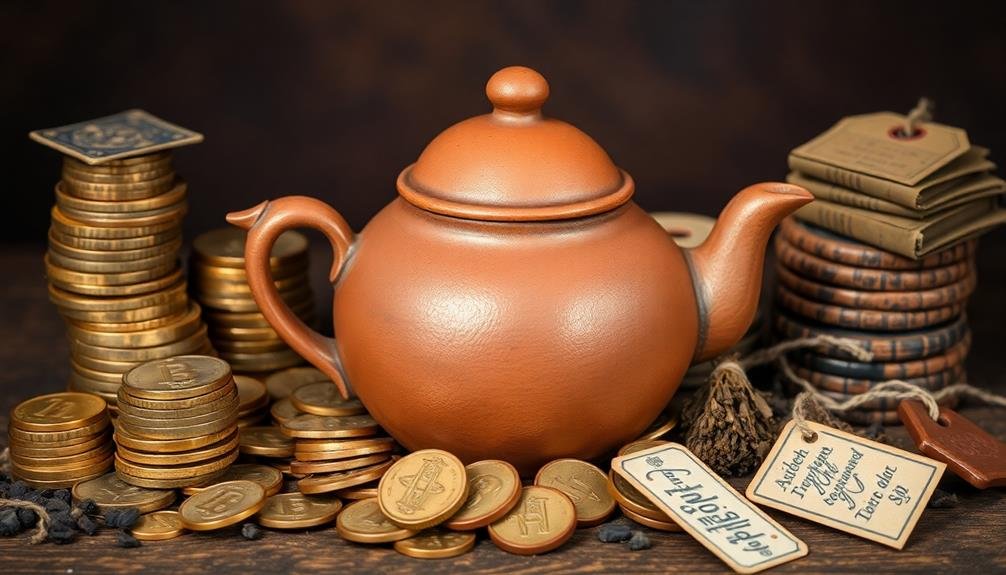
Beyond their functional aspects, clay teapots can also be valuable investments. As you explore the world of clay teapots, you'll find that certain pieces appreciate in value over time. Antique and artisanal teapots, especially those crafted by renowned potters, can fetch significant prices in the collector's market.
When considering a clay teapot as an investment, focus on quality, craftsmanship, and rarity. Look for teapots made by skilled artisans or from reputable workshops. Limited edition pieces or those with unique designs often command higher prices. The age and condition of the teapot also play vital roles in determining its value.
Here's a quick guide to help you understand the investment potential of clay teapots:
| Factor | Impact on Value | Examples |
|---|---|---|
| Artisan | High | Yixing masters, famous potters |
| Age | Moderate to High | Antique Qing dynasty teapots |
| Rarity | High | Limited editions, unique designs |
Frequently Asked Questions
Can Clay Teapots Be Used With Electric Kettles or Stovetops?
No, you shouldn't use clay teapots on electric kettles or stovetops. They're not designed for direct heat and can crack or break. Instead, heat water separately and pour it into your clay teapot for brewing.
Are Clay Teapots Dishwasher-Safe?
You shouldn't put clay teapots in the dishwasher. They're porous and can absorb soap, affecting tea flavor. Hand-washing is best. Use warm water and a soft brush, avoiding harsh detergents. Dry thoroughly to prevent mold growth.
How Long Does It Take to Properly Season a New Clay Teapot?
You'll need patience to season a new clay teapot properly. It typically takes 2-4 weeks of regular use. Brew tea daily, allowing the pot to absorb flavors gradually. Don't rush the process; it's essential for enhancing your tea experience.
Can Clay Teapots Be Used for Brewing Coffee or Other Non-Tea Beverages?
You can use clay teapots for coffee or other beverages, but it's not ideal. They'll absorb flavors, potentially altering future brews. It's best to stick with tea, especially if you've seasoned your teapot for specific varieties.
Do Clay Teapots Contain Lead or Other Harmful Substances?
You shouldn't worry about lead in most modern clay teapots. They're typically made with food-safe materials. However, it's always wise to check with the manufacturer or seller to confirm there aren't any harmful substances in your teapot.
In Summary
You've discovered the magic of clay teapots for herbal teas. They're porous, retain heat well, and enhance flavors. Over time, they'll season naturally, improving your tea experience. Don't forget their aesthetic appeal and health benefits. With proper care, your clay teapot will be a valuable investment. Consider the size and shape that best suits your needs. Embrace the art of brewing in clay, and you'll elevate your herbal tea rituals to new heights.





Leave a Reply